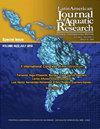Effect of the water exchange rate in a recirculation aquaculture system on growth, glucose and cortisol levels in Oreochromis niloticus
IF 0.8
4区 农林科学
Q3 FISHERIES
Latin American Journal of Aquatic Research
Pub Date : 2022-05-01
DOI:10.3856/vol50-issue2-fulltext-2790
引用次数: 0
Abstract
In recirculating aquaculture systems (RAS), the water exchange rate influences the removal of waste compounds. However, the inappropriate exchange rate favors the presence of stress factors, causing alterations in the cultured organisms. Therefore, the aim was to determine the effect of the water exchange rate in the different productive stages (fingerling, juvenile, and adult) of Nile tilapia (Oreochromis niloticus). Three exchange rates were used: rates of 1.2 (T1), 2.8 (T2), and 5.3 (T3) tank volume h-1. The following were established as response variables: growth rate (GR), survival rate (SR), feed conversion rate, protein efficiency, and condition factor. Likewise, cortisol and glucose concentrations were established as explanatory variables. The results suggest that in the fingerling stage, the T2 treatment contributes most to the productive performance (GR = 40.24 g and SR = 95%), keeping low levels of cortisol and glucose (6.76 ng mL-1 and 33.73 mg dL-1). In the juvenile stage, T3 treatment shows the best result both in productive performance (GR = 117.69 g and SR = 90%) and in cortisol and glucose concentrations (35.13 ng mL-1 and 70.67 mg dL-1). Finally, all treatments present cortisol and glucose levels above the normal range in the adult stage, T1, where the highest productive performance is presented (GR = 90.06 g and SR = 95%). The information leads us to consider the variation in the exchange rate in a RAS through the different stages of the Nile tilapia to maintain the favorable conditions that lead to the highest performance.循环水养殖系统中水交换率对尼罗褐虾生长、葡萄糖和皮质醇水平的影响
在循环水产养殖系统(RAS)中,水交换率影响废物化合物的去除。然而,不适当的汇率有利于压力因素的存在,导致培养的生物体发生变化。因此,目的是确定尼罗河罗非鱼(Oreochromis niloticus)不同生产阶段(幼鱼、幼鱼和成年鱼)的水交换率的影响。使用了三种交换速率:1.2(T1)、2.8(T2)和5.3(T3)罐体积h-1的速率。以下被确定为反应变量:生长率(GR)、存活率(SR)、饲料转化率、蛋白质效率和条件因子。同样,皮质醇和葡萄糖浓度被确定为解释变量。结果表明,在手指阶段,T2治疗对生产性能的贡献最大(GR=40.24 g,SR=95%),保持皮质醇和葡萄糖的低水平(6.76 ng mL-1和33.73 mg dL-1)。在幼年期,T3治疗在生产性能(GR=117.69 g,SR=90%)和皮质醇和葡萄糖浓度(35.13 ng mL-1和70.67 mg dL-1)方面表现出最佳效果。最后,在成年期T1,所有治疗的皮质醇和葡萄糖水平都高于正常范围,其中表现出最高的生产性能(GR=90.06 g,SR=95%)。这些信息使我们考虑到在尼罗河罗非鱼的不同阶段,RAS中汇率的变化,以保持最佳性能的有利条件。
本文章由计算机程序翻译,如有差异,请以英文原文为准。
求助全文
约1分钟内获得全文
求助全文
来源期刊

Latin American Journal of Aquatic Research
FISHERIES-MARINE & FRESHWATER BIOLOGY
CiteScore
1.70
自引率
10.00%
发文量
44
审稿时长
4-8 weeks
期刊介绍:
Latin American Journal of Aquatic Research- LAJAR is the continuation of the journal Investigaciones Marinas (1970-2007) and is published since 2008 by the Escuela de Ciencias del Mar, Facultad de Ciencias del Mar y Geografía of the Pontificia Universidad Católica de Valparaíso. LAJAR is an “Open Access” journal that publishes in English language, original research articles, reviews and short communications on aquatic science, which contain the results of research conducted in aquaculture or in oceanic and coastal marine waters of Latin America.
The following topics are considered: Physical Oceanography, Chemical Oceanography, Marine Biogeochemistry, Marine Pollution and Toxicology, Marine Geology and Geophysics, Biological Oceanography, Fisheries and Aquaculture.
 求助内容:
求助内容: 应助结果提醒方式:
应助结果提醒方式:


